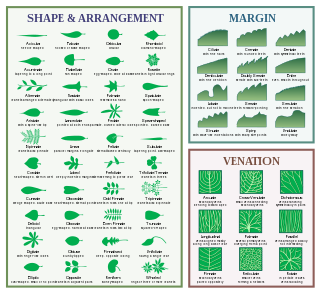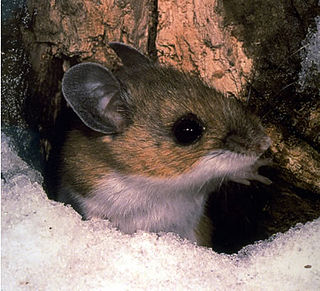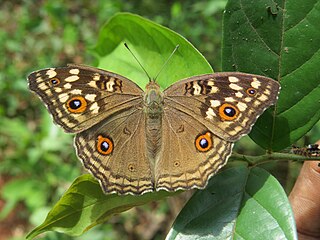
Botany, also called plant science, plant biology or phytology, is the science of plant life and a branch of biology. A botanist, plant scientist or phytologist is a scientist who specialises in this field. The term "botany" comes from the Ancient Greek word botanē (βοτάνη) meaning "pasture", "herbs" "grass", or "fodder"; Botanē is in turn derived from boskein, "to feed" or "to graze". Traditionally, botany has also included the study of fungi and algae by mycologists and phycologists respectively, with the study of these three groups of organisms remaining within the sphere of interest of the International Botanical Congress. Nowadays, botanists study approximately 410,000 species of land plants, including some 391,000 species of vascular plants and approximately 20,000 bryophytes.

Family is one of the eight major hierarchical taxonomic ranks in Linnaean taxonomy. It is classified between order and genus. A family may be divided into subfamilies, which are intermediate ranks between the ranks of family and genus. The official family names are Latin in origin; however, popular names are often used: for example, walnut trees and hickory trees belong to the family Juglandaceae, but that family is commonly referred to as the "walnut family".

The ferns are a group of vascular plants that reproduce via spores and have neither seeds nor flowers. They differ from mosses by being vascular, i.e., having specialized tissues that conduct water and nutrients, and in having life cycles in which the branched sporophyte is the dominant phase.

Acanthaceae is a family of dicotyledonous flowering plants containing almost 250 genera and about 2500 species. Most are tropical herbs, shrubs, or twining vines; some are epiphytes. Only a few species are distributed in temperate regions. The four main centres of distribution are Indonesia and Malaysia, Africa, Brazil, and Central America. Representatives of the family can be found in nearly every habitat, including dense or open forests, scrublands, wet fields and valleys, sea coast and marine areas, swamps, and mangrove forests.

The following terms are used to describe leaf morphology in the description and taxonomy of plants. Leaves may be simple or it may be compound. The edge of the leaf may be regular or irregular, may be smooth or bearing hair, bristles or spines. For more terms describing other aspects of leaves besides their overall morphology see the leaf article.

The New World rats and mice are a group of related rodents found in North and South America. They are extremely diverse in appearance and ecology, ranging from the tiny Baiomys to the large Kunsia. They represent one of the few examples of muroid rodents in North America, and the only example of muroid rodents to have made it into South America.

The Neotominae are a subfamily of the family Cricetidae. They consist of four tribes, 16 genera, and many species of New World rats and mice, predominantly found in North America. Among them are the well-known deer mice, white-footed mice, packrats, and grasshopper mice.

Junonia lemonias, the lemon pansy, is a common nymphalid butterfly found in Cambodia and South Asia. It is found in gardens, fallow land, and open wooded areas.

Edward William Nelson was an American naturalist and ethnologist. A collector of specimens and field naturalist of repute, he became a member of several expeditions to survey the fauna and flora. He was part of a team with Clinton Hart Merriam that took part in the Death Valley Expedition. He also explored the Yosemite Valley. A number of vertebrate species are named after him.

State Route 187 is a primary state highway in the U.S. state of Virginia. The state highway runs 5.43 miles (8.74 km) from SR 658 at Guilford east to SR 679 in Modest Town. SR 187 connects U.S. Route 13 with Bloxom in northern Accomack County.
Goldman's diminutive woodrat is a species of rodent in the family Cricetidae. It is found only in Mexico.
Nelsonia is a genus of rodent in the family Cricetidae, found in Mexico. It contains the following species:
The diminutive woodrat is a species of rodent in the family Cricetidae. It is endemic to Mexico.

Pinus nelsonii, Nelson's pinyon, is a species of pine native to the mountains of northeastern Mexico, in Nuevo León, San Luis Potosí and Tamaulipas at 1,800–3,200 m altitude.

Nelsonia is a census-designated place (CDP) in Accomack County, Virginia, United States. Per the 2020 census, the population was 451.
Abatetia is a genus of flies in the family Dolichopodidae. It contains a single species, Abatetia robusta, and is found in New Zealand. The genus was originally known as Nelsonia, named by Octave Parent in 1933. The genus was then transferred to Cymatopus by Parent in 1937. Separately, David Miller found the name Nelsonia to be preoccupied by Nelsonia, and renamed it to Abatetia in 1945. However, the genus remained a synonym of Cymatopus until 1984, when it was restored as a separate genus by Henk J. G. Meuffels and Patrick Grootaert. Due to Nelsonia being preoccupied, Abatetia became the name of the genus.

Ptychopariidae is a family of trilobites, containing the following genera:

Nelsonia canescens is a herbaceous plant species in the family Acanthaceae, with a substantial number of similar plant specimens now identified as synonyms.

Nelsonia is a genus of plants in the family Acanthaceae. They can be found in tropical: Africa, Latin America, south-east Asia and Australia.














